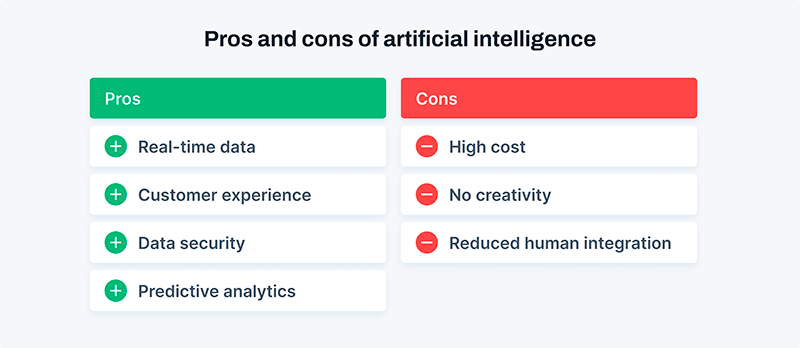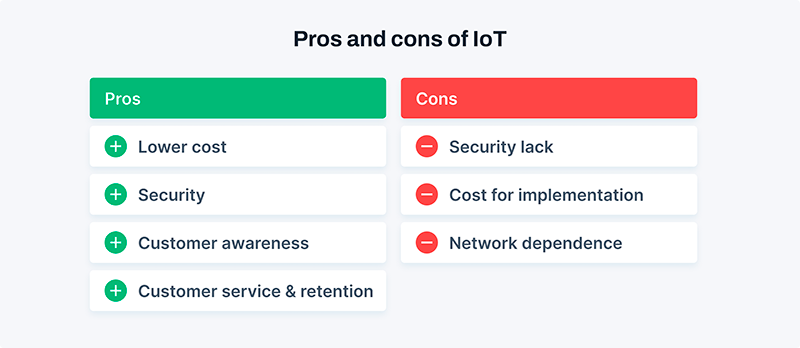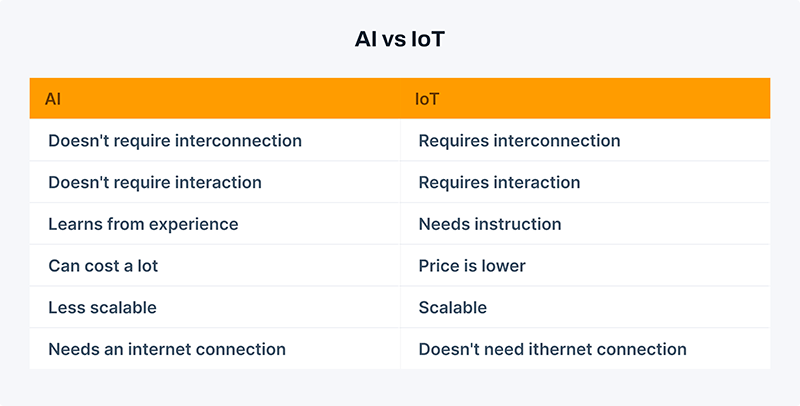IoT vs. AI: What's the Difference & Which Is Better?
February 16, 2024In today's fast-paced technological world, two major innovations are driving the transformation: artificial intelligence (AI) and the Internet of Things (IoT). Although they have different focuses and functionalities, AI and IoT are becoming increasingly connected and are revolutionizing industries, changing how we interact with technology.
It is crucial to understand the differences between AI and IoT, to navigate the complexities of modern advancements, and to harness their full potential. This article delves into the essence of AI and IoT, highlighting their definitions, focuses, functionalities, benefits, and disadvantages. Let’s unravel the intricacies of these transformative technologies and glimpse into the boundless possibilities they offer for innovation, efficiency, and progress.
What is AI?

Artificial intelligence is the creation of machines that can perform tasks requiring human-like cognitive abilities by simulating human intelligence. These machines were designed to learn from data, understand language, and solve complex problems, imitating human behavior.
Artificial intelligence has various applications, from virtual assistants to advanced healthcare, finance, and transportation systems. AI builds intelligent systems that can perform tasks requiring human-like cognitive abilities.
Top 4 benefits of AI
Real-time data
Real-time analytics empowers businesses to handle vast amounts of data, offering real-time insights. This capability stands as a paramount advantage of AI in the business area. By processing data, enterprises can easily make critical decisions, staying ahead in a fast-paced market landscape.
Customer experience
AI chatbots provide 24/7 user support, ensuring prompt assistance at any time. With improved communication and quicker response times, businesses bolster customer loyalty and attract new patrons. This personalized interaction satisfies existing customers, which attracts prospective ones, enriches the overall customer experience, and fosters lasting relationships.
Data security
Data security is crucial in identifying fraudulent activities and unauthorized access to sensitive information. Many finance and banking sectors rely on AI technology. By analyzing large amounts of data, AI algorithms can quickly detect anomalies and suspicious patterns. This proactive approach strengthens trust in financial institutions, ensuring a secure and reliable banking experience.
Predictive analytics
AI technology can handle vast amounts of data, identifying patterns and predicting future trends. Many businesses find predictive insights valuable for minimizing risks and making informed decisions. AI helps companies anticipate outcomes and proactively mitigate risks, improving their strategies and outcomes.
Disadvantages of AI
High-cost implementation
Incorporating AI into app development is a time-consuming and costly endeavor. Creating AI-integrated software programs entails complexity and requires significant investment. Despite the initial financial outlay, the long-term benefits of AI, such as improved efficiency and enhanced user experience, often outweigh the upfront costs. Moreover, businesses must consider ongoing maintenance and training costs to ensure optimal performance and relevance of AI technologies over time.
No creativity
AI is highly efficient at learning from pre-fed data and experience, but it cannot think creatively. Although it can process vast amounts of information and generate solutions based on existing patterns, it cannot replicate the imaginative and innovative thinking characteristic of humans. Creativity involves abstract thinking, emotional understanding, and intuition, which are areas where AI currently falls short. Although AI can assist in tasks requiring logical reasoning and problem-solving, innovative and groundbreaking ideas still rely on human creativity and ingenuity.
Reduces human intervention
Applications can simplify repetitive and mundane tasks, reducing the need for humans to remember details and solve routine issues. Although this convenience can result in a decline in motivation and initiative, it also allows individuals more time and mental energy for more creative and meaningful pursuits. However, excessive dependence on AI for simple tasks may hinder the development of critical thinking and problem-solving abilities if it is not balanced with opportunities for active engagement and learning.
What is IoT?

The IoT is all about connecting everyday objects to the internet so that they can communicate and share data with us. These objects, ranging from household appliances like fridges to vehicles, are equipped with high technology, such as sensors and software, that enable them to transmit and receive information.
This connectivity paves the way for innovations such as wearable technology, smart cities, and homes that automatically adjust temperature and lighting. It's transforming our world into a more interconnected place through intelligent devices.
Top 4 benefits of IoT
Cost saving
The IoT can save businesses money. It keeps attention on equipment, predicting issues before they cause delays. Less downtime and more productivity give companies a competitive edge.
Customer awareness
Knowing what customers like is crucial for businesses. IoT helps gather data from social media, video, mobile, and the internet, giving insights into consumer behavior. It helps companies understand their preferences and improve their chances of success.
Customer service and retention
Businesses can provide better customer service with IoT. By gathering data from smart devices, they understand what customers want. It improves things like automatic tracking after sales, thus keeping customers happy and coming back.
Security
Businesses can create high-security products by using IoT technology in devices like surveillance cameras and motion sensors, thus ensuring that customers' properties are well protected.
Disadvantages of IoT
Security lack
Security can be a concern with IoT. Since it gathers data from different places, there's a risk that it won’t offer the best security.
Cost implementation
Setting up IoT in a business involves creating a network with smart devices, a power grid, and a communication system. Doing all this can be expensive.
Network dependence
The IoT is a vast network of connections between various devices. They are all connected to the global network. These networks are interdependent, meaning that if one device experiences an error, it can affect the operation of other devices.
Differences between AI and IoT
AI is robust software capable of cognition, learning, and adaptation to human interactions. The difference between AI and IoT lies in their functionalities: AI processes data to make informed decisions, while IoT captures and stores data. However, the convergence of AI and IoT, known as AI-enabled IoT, brings synergies.
AI learns patterns and behaviors, while IoT focuses on sensor data collection. AI relies on deep learning algorithms to mimic system behavior, whereas IoT facilitates algorithm development to express system behavior. In spontaneous reactions to input, AI contrasts with IoT's storage of predefined responses triggered by devices.
This article provides a comprehensive comparison between AI and IoT across various aspects such as purpose, dependability, cost, data requirements, and success rates. It highlights their distinct roles, functionalities, and challenges while exploring the intersection of AI and IoT, known as AI-enabled IoT. Additionally, it sets the stage for further discussion on the differences, challenges, and opportunities in implementing AI and IoT technologies, particularly in AI-enabled IoT initiatives.
Purpose
While AI can complement IoT, their objectives remain distinct. IoT serves as a network enabling global connectivity and autonomous interaction with physical objects, utilizing sensors, actuators, and electronics to transmit data over the internet. In contrast, AI endeavors to replicate human intelligence, fostering empathetic behavior and facilitating human-machine collaboration.
AI-driven personalized recommendations exemplify its utilization, while IoT's functionality extends to temperature and motion sensors for data collection and interaction. The convergence of AI and IoT, or AI-enabled IoT, augments their capabilities, unlocking new possibilities for intelligent, interconnected systems.
Dependability
Dependability varies between IoT and AI, reflecting their distinct roles and characteristics.
IoT facilitates seamless data exchange among physically connected devices, while AI enhances data comprehension. The interconnected nature of IoT generates vast data volumes, necessitating intelligent analysis to extract insights. Consequently, IoT exhibits higher dependability compared to AI systems.
In contrast, AI systems rely on human intervention, particularly during development and training. They may also require human oversight to address challenges such as adversarial attacks and model drift, which can impact performance. This dependency on human intervention distinguishes AI from IoT, highlighting the need for collaborative approaches in AI-enabled IoT systems.
Cost
AI systems generally require a higher investment than IoT due to their complex configuration requirements.
For IoT projects, expenses typically include host servers (if required), hardware, wireless connectivity, and software development. Despite these costs, the IoT tends to be more affordable than AI. Moreover, the ability to control IoT devices using portable electronics like smartphones reduces the need for specialized controllers, further lowering expenses.
On the other hand, AI projects involve expenditures related to data collection, software development, model deployment, data lakes/warehouses, and system architectures. AI systems require highly configurable architectures to handle extensive computations, often necessitating remote servers at a slightly higher cost. This distinction in price reflects the differing requirements and functionalities of AI and IoT, highlighting the importance of strategic budget allocation in AI-enabled IoT initiatives.
Data requirements
Data is a cornerstone for AI and IoT, yet their requirements and management differ significantly.
In the IoT, data collection relies on hardware systems and sensors, which gather, store, and retrieve data as needed. The volume and quality of data collected depend on the number and type of sensors utilized, making sensor deployment crucial for effective data collection.
On the other hand, AI's foundation lies in comprehending patterns and behaviors, requiring massive amounts of data encompassing patterns, trends, and human behavior insights. Preprocessing and relevance are vital for AI data, particularly for tasks like data modeling. In contrast to IoT, where sensor deployment leads to data collection b, AI emphasizes data quality and preprocessing to produce meaningful insights and facilitate intelligent decision-making.
Positive rates
In comparison, AI projects generally experience a lower success rate than those involving the Internet of Things.
IoT's understanding of consumer behavior and decision-making processes is crucial for business success. IoT enables businesses to achieve this by collecting, tracking, and analyzing data from various sources, such as mobile devices, social media, video surveillance, and internet usage. Its straightforward and practical systems contribute to slightly higher success rates than AI.
According to an IDC survey, only 30% of organizations reported the highest success rates for AI projects, with failure rates ranging from 10% to 49% in the remaining cases. One significant contributing factor to AI project failures is the requirement for more data usage in terms of quality and quantity. It highlights the difference between AI and IoT, underscoring the need for careful planning and data management in AI-enabled IoT initiatives.
AI and IoT: Which is better?
AI vs. IoT: though distinct, they intersect to revolutionize industries by offering boundless possibilities. Explore their differences and applications in the comparison table below.
| Category | AI | IoT |
|---|---|---|
| Connectivity | Independent and doesn't require interconnecting | Interconnected devices over a network |
| Capability | Capabilities can’t be predicted | Device capabilities are known in advance |
| Interaction | AI doesn’t require individual interaction | Require individual interaction |
| Instructions | Machines learn from experience | Devices need instructions |
| Dependence | AI can work without IoT | IoT won’t work without AI |
| Cost | AI can cost a lot | The price is substantially lower |
| Object | Doesn’t require an object | IoT primarily revolves around objects embedded with technology capable of capturing sensory movements. |
| Applications | It can be chatbots, natural language processing, speech recognition, machine vision, etc. | It can include smart wearables, smart cities, smart homes, water monitoring, etc. |
| Scalability | Less scalable | Scalability based on cloud |
| Online/offline | AI needs to be connected to the Internet | IoT can work without the Internet |
There is no straightforward answer to whether IoT or AI is better. Both IoT and AI offer significant potential and exciting opportunities. When companies need to gather real-time data, IoT is often a preferred option. It is beneficial for continuous, remote monitoring of physical assets. Besides, if companies already have ample data sources and aim to extract insights and make predictions, they find better value in employing AI over IoT, or AI-enabled IoT.
AI can delve into historical data and derive actionable insights without additional IoT sensors. Ultimately, the decision between IoT and AI depends on the specific problem to solve, whether it involves generating and interpreting data or addressing issues related to human errors and productivity.
IoT taps into the power of AI to boost the intelligence and capabilities of IoT devices and networks. These devices can now collect, analyze, and respond to data in more sophisticated and autonomous ways.

Conclusion
AI and the IoT are distinct yet complementary concepts. AI systems analyze and automate tasks using data from IoT devices, emphasizing analysis and decision-making, while IoT focuses on connectivity and automation.
While there are differences between AI and IoT, both can significantly impact business processes when utilized effectively. Furthermore, the convergence of AI and IoT, known as AI-enabled IoT, further enhances their capabilities, offering new possibilities for intelligent systems. However, it's important to note that each technology has its advantages and disadvantages.
FAQ
What is the difference between AI and IoT?
AI focuses on understanding and making decisions according to data, while IoT is about connecting devices and automating processes. AI systems can learn and automate tasks using data from IoT devices.
How do AI platforms differ from IoT platforms?
AI platforms focus on data analysis and decision-making, while IoT platforms emphasize connectivity and automation of devices.
What is the connection between IoT and AI?
AI enhances IoT by analyzing data from connected devices, enabling intelligent decision-making and automation, thus optimizing IoT functionality.
How are AI and IoT different?
Together AI and IoT leverage data for insights, enabling automation and improving efficiency in various domains such as healthcare, manufacturing, and smart cities.
Is IoT a form of AI?
AI is not inherently a component of the IoT but often complements it. While IoT focuses on connectivity and data collection, AI adds intelligence by analyzing data from IoT devices for decision-making and automation.
What is the three-way symbiotic relationship between IoT, AI, and cloud?
The symbiotic relationship between the IoT, AI, and cloud involves IoT devices collecting data, AI analyzing it for insights, and the cloud providing storage and computing power to support AI algorithms, enabling smarter IoT applications.
IoT vs. AI: Which is better?
There is no definitive answer, as both have unique strengths. IoT excels in data collection and automation, while AI analyzes data for insights and decision-making. The choice depends on the specific needs and objectives of a project.


